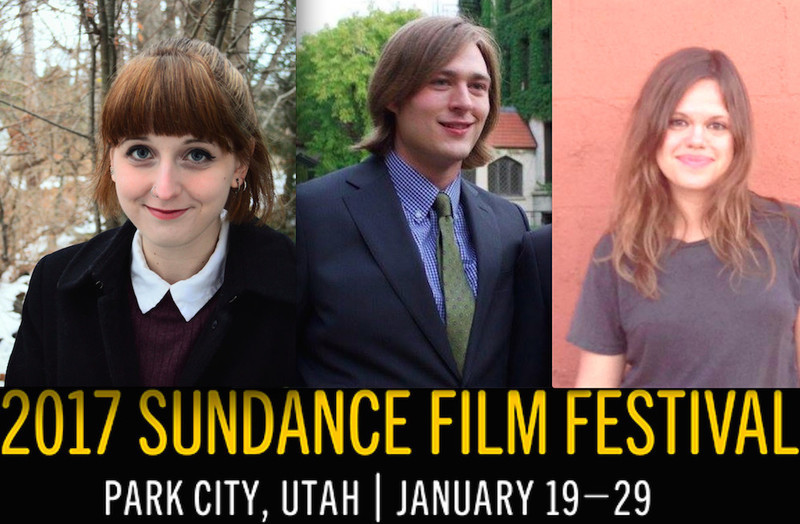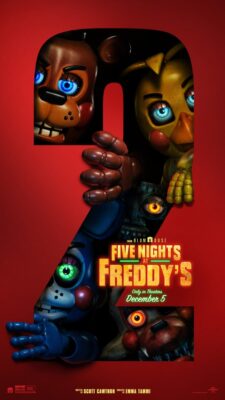We asked our three Ebert Fellows to share their thoughts on their Sundance 2017 experience. It was a pleasure and an honor to work with these passionate young writers, and it’s doubtful this is the last you’ll hear from them. Click on the links below their names to read their individual pieces.
EMMA PIPER-BURKET
Sundance 2017 Interview: “Kuso“
Empathy, kindness, compassion, and forgiveness: Chaz invited us as Ebert Fellows to explore this year’s Sundance Film Festival from the lens of these four words. In doing so, she cast a lifeline of support that carried me through some of the most politically and emotionally challenging days I’ve experienced as a citizen of the United States.
Sundance is its own ecosystem. When you enter its sphere, the rest of the world becomes very remote. The geography, covered in snow, the shared experience of many people gathering for a common purpose; the branded water bottles, bags, hats, and accreditation badges that make you feel part of a cohesive alternate reality. News from the “outside” coming through Twitter and Facebook feeds in between screenings created an even bigger disconnect over these past 10 days. I found myself in an unreal world, while simultaneously the world outside was rapidly changing (deteriorating). The first film I saw at Sundance was on opening night, “I don’t feel at home in this world anymore.” The title of Macon Blair’s dark comedy so deeply resonated with my personal feelings throughout the festival, that it came as no surprise that the film turned out to be the Grand Jury winner—as if its title and ethos was speaking to something embedded deep within the atmosphere.
During the morning of the inauguration I went to a screening of “An Inconvenient Sequel: Truth to Power,” followed by the portrait of Wendell Berry, “Look & See.” I went to these films in an attempt to remedy my growing unease, as if spending time with these two men (Al Gore and Wendell Berry), who have devoted their lives to values I believe in—stewardship for the planet and inherent respect for life—would help bolster support for those values universally. This is the power that film has, it can be entertainment, but it can also act as a balm, soothing the tender spots and internally strengthening what we hold most dear.
Amidst the political chaos going on in the outside world, I found myself searching for meaning and answers within the films that I watched each day. How did we get here? Are we equipped for what’s coming next? What is the creative film industry doing (or going to do) to combat the situation? In difficult times, human effort, achievement, suffering and joy feel all the more poignant. Almost every screening was an emotional experience: an acknowledgement of the struggle, passion and energy that brought us all to that moment in the darkened theater in front of a bright screen. Maybe this all sounds melodramatic, but we are living in dramatic times and as part of a creative community, I’m going to allow myself to feel.
Back to these four words and how they colored my first Sundance experience. Empathy is the feeling when the journalists from Raqqa is Being Slaughtered Silently came in front of the audience after the screening of Matthew Heinemen’s “City of Ghosts,” the heavy weight of all we had just witnessed onscreen standing before us in human form. This is the work of films at their best, to allow us to feel what others have felt. Compassion goes hand in hand with empathy—we see struggles and successes onscreen and are able to extend ourselves to share a small fragment of that experience. The bus drivers, the festival volunteers, organizers and fellow festival-goers, everyone in Park City was extremely kind and generous with their knowledge and time- so kindness was a constant during my time at Sundance. Over these past accelerated days, I realized how deeply important it is for us all to have forgiveness for others and for ourselves. There is so much pressure to do and see and be so many things, so forgiveness for each person who feels like they are not doing enough, creatively, politically, or otherwise. I would add a fifth word: gratitude, for the Sundance community, for the film world, for Chaz and the team at RogerEbert.com, and for being able to interface with it all.
SASHA KOHAN
Sundance 2017: The Filmmakers of “Quest“
Sundance, for me, began and ended with nuns. “The Little Hours,” a medieval comedy with all the sex, drugs, and dormitory drama of my freshman year in college, was the first film I saw in Park City; “Novitiate,” a 1960s coming-of-age story centered on one convent’s resistance to the reforms of Vatican II, was the last. In between were twenty other screenings, a handful of panels, one inauguration, and countless conversations in lines and on buses about all of it.
It’s bizarrely serendipitous that my Sundance experience was bookended by religion—partly because religion is generally of no interest to me, but also because of a strange conversation I had on my way to the airport two weeks ago, with my Lyft driver. Here’s the scene: I’m telling him about my upcoming adventure, about the movies I’ll see and essays I’ll write, how I’m a little anxious about finding time to do it all, but ultimately reassured by the alternative-lazy mantra, “I work better under pressure.” He asks me about my work ethic and personal philosophies, and eventually comes to the question of whether I believe in God. I’m clearly thrown off, and he quickly adds, “Sorry—I’m a Mormon now, but I’ve been where you are.” This is the kind of vaguely patronizing, you’ll-find-out-when-you’re-older attitude from some believers to non-believers that makes me feel defensive of my somewhat superstitious, sometimes magical, always contradictory beliefs in what is absurd and what is meaningful. “I believe in some things!” I want to say. “I have some convictions, you know!” But I try not to become impatient with his faith, because we still have 20 minutes in the car together, and he just wants to know more about the way I think. So, we listen to each other’s stories about how we got to where we are, we each bring up points that bring the other to silence before responding, and when we get to the airport, he lifts my suitcases out of the trunk and asks if he can shake my hand. “It was very interesting talking with you, Sasha,” he says. His name was Daniel. “Are you sure you don’t want a pamphlet?”
Technically, Sundance for me began with Daniel. We never once mentioned politics, compassion, kindness, empathy, or forgiveness, and we certainly didn’t change each other’s minds—but our exchange kept coming up as I navigated my way to liberal Sundance spots through the overwhelmingly red streets of Utah, and it remains exemplary in my head of how to go forward in the messy reality of all these things. I think about ‘religious tolerance,’ and Sue Obeidi from the Muslim Public Affairs Council speaking at the Women’s March, letting everyone know, “I don’t want to be ‘tolerated.’ I want to be respected and accepted and I want to be celebrated.” At that march, in the car with Daniel, as part of an audience of over 1,000 who went to see “An Inconvenient Sequel” on Inauguration Day—remembering those moments of unity and how they felt even when I was utterly disconnected from reality, guilty and grateful to be stuck in the bubble of storytelling that was Sundance, reminds me that there are so many more Daniels than there are Trumps. The ordinary people who are as steadfast in their own selves as they are in their willingness to accept, respect, and celebrate the differences of others far outnumber those in power who may use their own faith, gender, or skin tone as a crutch to stifle something they refuse to understand; something grown and honed in us over years of reading novels and watching movies, the kind of movies Sundance is known to produce: the ability to imagine the feelings of another, to put yourself in their shoes. Empathy is a civilian trait we may see not in the actions of our government, but in those little moments where we find the will to give time to learning about the lives of others, even in something as radically small as seeing a movie, or reading a novel, or—I don’t know—asking strangers how they feel about God.
WALKER KING
Sundance 2017 Interview: “Person to Person“
Sundance 2017: “78/52“
Sundance 2017: Trump and the Politics of Film Festivals
At my first Sundance, I sometimes felt like a turn-of-the-century hayseed at the World’s Fair, gawking at the marvels of civilization on display. “These city folks got flying machines,” I write home to the farm. “They got black discs what can talk. They got self-referential homages to Yasujiro Ozu set in a small town in Indiana, Bertha.” Maybe I haven’t been paying enough attention to the last couple years of cinema, or maybe I’m just easily impressed, but this year’s Sundance offerings felt like an embarrassment of riches. I wasn’t as hot on “Thoroughbred” and “Berlin Syndrome” as some people, but a year at the movies featuring “A Ghost Story,” “Call Me By Your Name,” “Person to Person,” “Columbus,” “Raw,” “Kuso,” “Mudbound,” and “Machines” is quite the accomplishment, assuming they all make it to theaters. It’s enough to make me look back at earlier years and wonder what I’ve been missing out on.
Most of those movies are deserving of more detailed analysis, and have gotten it elsewhere, but a personal feeling I was surprised to walk away from Sundance with was a sense of anticipation for the eventual cultural moments we’ll have around these films. I can hardly wait to go see “Brigsby Bear” with my parents, or to carry on about “A Ghost Story”’s philosophy, or subject my friends to “Kuso”’s visionary psychosis. Of course, it’s impossible to predict what kind of impact, if any, these Sundance titles will have. I feel a misplaced, more-than-a-little-weird, sense of parental fear as I think about these little movie babies venturing out into the big, unwelcoming, world, but a similar sense of pride in what they’ve accomplished already.
Sundance has a kind of weird flow that took me a little time to get the hang of. I started with a list of about 30 movies I was interested in, subtracted a few with middling responses, added a few that picked up strong buzz, then subjected it to a daily wringer of ticket requests, bus delays, and waitlist lines that forced me to drop what I couldn’t get to and add in whatever I could. By the end of the festival I’d been able to fit in 26 movies, but I’m sure I never would have been able to predict beforehand what those 26 were going to be. I think this catch-as-catch-can experience is something richer and more memorable than if I’d simply queued up 30 movies on Netflix for a week and a half. The lows seem lower when you realize you could have spent your time seeing a future masterpiece, and the highs seem higher when you stood in a blizzard for half an hour to get to them.
I’ve always tended to look at Sundance as a road-map for the year to come, but this year, having seen so many movies that I would usually be waiting for until awards season, 2017 seems wild and unpredictable. Maybe nothing will come close to “Call Me By Your Name,” or maybe I’ll be chiding myself for my pessimism come December. At the very least, Paul Thomas Anderson is making a movie about 1950s fashion designers. That should be good.
To read all of RogerEbert.com’s coverage of Sundance 2017, click here.











